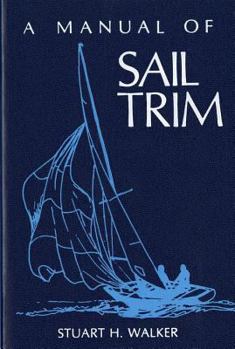Manual of Sail Trim
Select Format
Select Condition 
Book Overview
A guide for racing covers the principles of sail trim, crew movement techniques, maneuvers, and control systems, and gives advice on adjusting to special conditions.
Format:Paperback
Language:English
ISBN:0393032965
ISBN13:9780393032963
Release Date:July 1985
Publisher:W. W. Norton & Company
Length:252 Pages
Weight:0.70 lbs.
Dimensions:0.6" x 5.4" x 8.0"
Customer Reviews
5 ratings
Good book on Marconi Rig sail trim
Published by Thriftbooks.com User , 20 years ago
This is not a book to read once and then go sailing and win. At least for me, I had to read a chapter or two, go out and try it, the read and repeat. The bit that helped me the most was the theory of the vang. I've used it for downwind legs to hold the boom down but not for upwind. With a bendy mast you can open up the leach by using the vang on the upwind legs too. It pushes the mast forward and induces a bend. With a stiff mast it closes off the leach. It's just one more control that I wasn't using well.The terms "power up" and "vector" and used all over the place, and honestly if I knew what would "power up" the boat while keeping my boat pointing all the time I wouldn't need this book, but there are clues as to what will help drive the boat.The text on the spinaker is also great. You really do need to keep the leading edge just at a curl and Stuart explains why. It does help, I pass boats going downwind all the time who have stalled their spinakers.If you are a serious single design racer you need this book. You PHRF'ers will rarely know if what you are doing helped other than to watch the knot meter. If you beat another boat, was it just sail area and hull length? Or did you really get the maximum performance out of your sails.And yes those tell-tails are key to seeing the air flow on the sail.
Two lessons learnt
Published by Thriftbooks.com User , 22 years ago
After reading this book, I learnt two important aspects of sail trim which helped improve my racing. 1. Tell tails are very important, especially regarding sail twist.2. The positioning of the jib track, whether forward or aft or inboard or outboard is crucial to maintaining speed on a tight reach.Therefore, I am happy with the purchase of the book. I have many other sail tuning books have not transferred any successful ideas to my racing skills.
Sail. Read. Think. Discuss. Repeat.
Published by Thriftbooks.com User , 23 years ago
If you've got a couple of seasons of serious sailing (racing) under your belt, and you're looking to improve your mastery of sail trim, this book can aid in understanding. This is not the most approachable read, but it's equally true that there is detailed knowledge here that you just won't find anywhere else.Another reviewer pointed out that the book is organized by sail controls, not by conditions, or shapes you want to achieve. But it's very important to point out that great information about desirable sail shapes and how they are appropriate to various conditions IS contained in the book. For instance, my understanding of how much sail twist to put in, based on wind strength and water smoothness comes from applying what I read in Walker.Here's how it works for me.Sail a bunch. Reach a threshold. Read Walker. Sail some more. Think. Sail some more. Attend a sail-trim seminar such as the one held by Kame Richards, in the Bay Area. Sail some more. Talk things over with guys I sail with. Sail some more. Improve. Repeat.You can't get better at sailing just by reading. No book can do that for you. But Walker is one way to get the in-depth knowledge you'll need to continue to improve.Don't let the term "vector" cause your brain to immediately turn off. Remember, "vector" is just a fancy word for a force applied in a specific direction. And we do use a few of those in sailing ;-)
The only book on sail trim you'll ever want to buy.
Published by Thriftbooks.com User , 26 years ago
I agree that the book is highly technical, perhaps to the point of being inaccessible to beginner sailors who are less familiar with the use of various controls or who never pay attention to sail shape. This book, however, is the only comprensive description of how to tune a boat I've ever found. You'll always keep it in your regatta gear bag. I don't know how I sailed without it.
A thorough understanding of the physics of sail trim
Published by Thriftbooks.com User , 27 years ago
This book takes a very technical look at sailing. The opening chapter will send you looking for that physics book from freshman year in college. But if you can get past the vector notation and force diagrams, the author offers some very specific information about trimming sails in different situations. The author uses many terms that are not in common everyday usage. This is fine as this is a book that tries to explain the why's of sail trim, not just the how's, but it would have been appreciated if the author defined these the first time each is used. As it is presented, you might need to read some paragraphs 2 or 3 times to grasp the concepts being discussed, or consult outside sources for definitions. However, if you are not one of the scientifically challenged, what you come away with is a more complete knowledge of sailing, and why different situations require different actions. This will invariably make you a better sailor.






